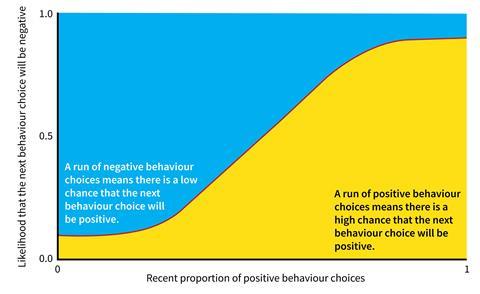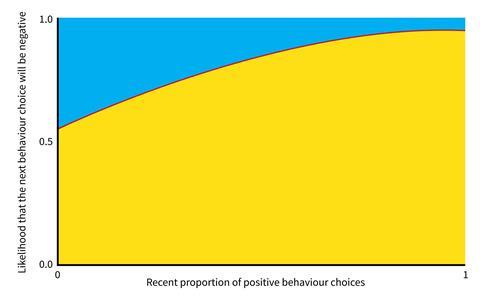How to avoid standards sliding and encourage pupils to play nicely

During lockdown I read The strategy of conflict by mathematician and Nobel laureate Thomas Schelling. It’s an amazing book about the type of maths used to understand cooperation, negotiation and conflict (you can read a key chapter here). The maths is known as game theory. If you’ve seen the movie A Beautiful Mind, you’ll know about game theory. I’ve since applied game theory to classroom behaviour choices and seen positive results.
When your students return to school in September, you can help them make positive behaviour choices. Inevitably, students will either choose to:
- settle down and work hard;
- mess around and have fun; or
- wait and see.
Which choices will be the most beneficial and least costly to them?
Behaviour choice is a game of strategy. Teachers and pupils benefit most when pupils work hard. So why doesn’t that always happen? Let’s explore some of the most effective strategies to set the right trajectory in the classroom.
The model of behaviour choice
I have adapted a choice model from Schelling’s book to visually describe these choices. I’ve called it the Model of behaviour choice.
A pupil’s behaviour choice is affected by the behaviour they witness around them. When the choices made are mostly positive, the pupil is more likely to make a positive choice. The opposite is also true.
When you reprimand your class, or promise a fun activity, you can temporarily break a series of negative behaviour choices, but the underlying pattern remains the same. You need to shift the chart in your favour.

This graph depicts a class with a culture where negative choices are unlikely and, even when they occur, the class is easy to resettle – practical work is purposeful and calm; students persevere when the work is hard.

Transform your classroom culture
There is plenty of advice about how to get this right. I often refer to Charlie Taylor’s behaviour checklist: Getting the simple things right. The Model of behaviour choice (MBC) helps explain why the strategies outlined in the checklist are effective and it can help you decide which ones to apply in your class:
- Meet and greet pupils when they come into the classroom.
If you start the lesson with a positive behaviour choice, subsequent choices are more likely to be positive. This year, if you can’t meet your students at the door, try other strategies. For example, have a simple short revision quiz on the board which everyone can do quickly and easily. Get any resources they’ll need ready and use a timer if you can. - Display rules in the class and ensure that the pupils and staff know what they are.
Make the outcomes of behaviour choices predictable and clear. During the cold war, it was vital each party knew that a threat or a promise would be delivered. Doubt causes costly mistakes (think Cuban Missile Crisis). One strategy to demonstrate commitment was to ‘burn bridges’, making the cost of reneging higher than the cost of delivering a threat or promise. Senior leaders can reduce the ‘cost’ of promises and threats for teachers by developing a simple, predictable, reliable and fair school-wide system of sanctions and rewards. - Display the tariff of sanctions and rewards in class.
The sanctions don’t need to be large. Scalable sanctions are useful to avoid a process known as ‘salami slicing’, where the pupil makes a series of small negative behaviour choices, each one too small to trigger the large consequence. The same is true of rewards. - Have a system in place to follow through with all sanctions and rewards.
Pupils need to know there will be consequences. This is often a weak link because teachers lack the time to follow through.
These strategies help shift the line on the chart upwards, reducing the likelihood of negative behaviour choices and cultivating a compliant class. But even though you may be developing the culture you want, some students could also have chosen the wait-and-see option. You want your pupils to go the other way and commit, so you need to make sure the rewards of hard work are reliable, achievable and not too distant.
A set of strategies usually applied to teaching and learning also applies to developing a culture of positive behaviour choices. I have also looked at how Barak Rosenshine’s Principles of instruction support the Model of behaviour choice:
- Present new material in small steps with practice after each step.
This builds pupil confidence as there isn’t a step where the pupil feels lost. The practice after each step gives pupils a sense of safe progress and success. - Provide models.
Show pupils what good work looks like so that they know what to aim for. When they feel lost, their confidence in achieving success decreases. - Guide student practice and provide scaffolds for difficult tasks.
Ensure students feel confident that positive choices lead to academic success. As you guide their practice, they know they are on the right track and making progress. - Obtain a high success rate.
Demonstrate to students that positive behaviour choices result in success. - Require and monitor independent practice.
This reassures pupils that if they’re going wrong, you’ll catch them before they waste too much effort. You’re also more likely to catch them making positive or negative choices. It’s important that your pupils are confident that you won’t miss an opportunity to reward or a need to sanction.
There’s a lot of good advice available about building strong classroom culture, but without a model it’s hard to choose the most relevant strategy. Game theory provides a model to help you prioritise and sequence classroom behaviour strategies. It also reveals how to develop your classroom culture beyond compliance to commitment.
Extra reading
- The evolution of trust (a wonderful game theory simulation)
- Thomas Schelling’s An essay on bargaining
Ben Rogers














No comments yet